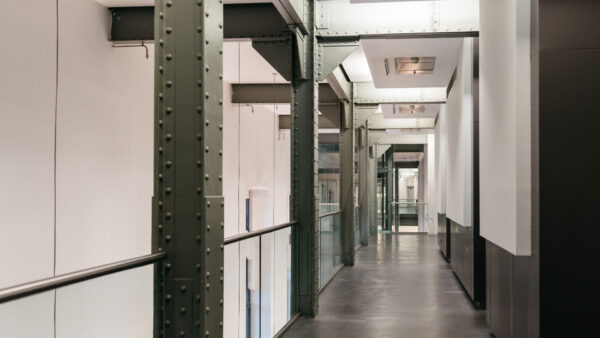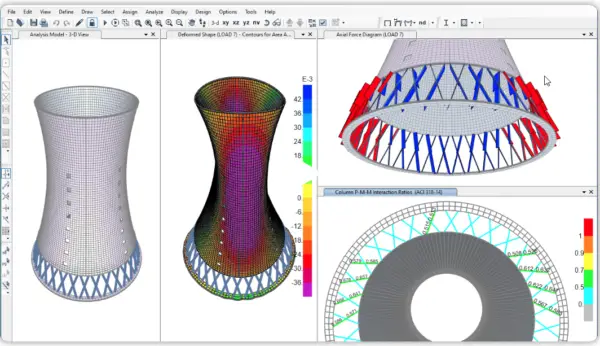Live loads or otherwise called super imposed loads are one important type of loading. To be considered by the engineer while designing a structure to ensure their safe design.
Loads are the forces that may cause stresses, deformations, displacement and accelerations on a building. A structure or building component may be subject to various types of loads. The nature of which will depend on its structural design, the location, and other factors.
For building structures and other built assets like tunnels, bridges, and dams, engineers include assessing loads in their structural design calculations.
Live loads, also known as imposed loads, are variable forces that are applied to a structure. Unlike dead loads, which are permanent and fixed, live loads can change in magnitude and location over the lifetime of a structure.
Properly accounting for live loads is crucial for civil engineers to design safe and serviceable structures. In this comprehensive guide, we will cover everything you need to know about live loads, including definitions, types, examples, calculations, and more.
The maximum loads that a structure must be able to resist are typically used to specify design requirements. Loads mainly come under two categories, one is gravity loads and other is lateral loads.
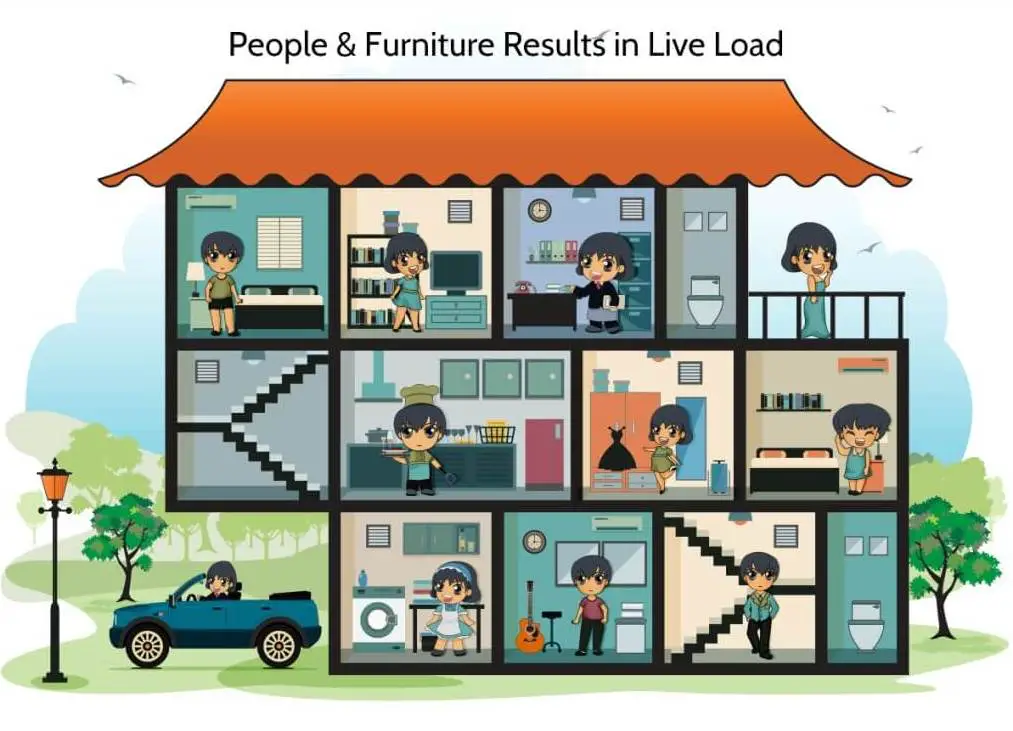
What is a Live Load?
A live load is defined as a non-permanent load that is applied to a structure and likely to change over its lifetime. Live loads are generally produced by the use and occupancy of a structure, rather than the structure’s own weight.
In other words, live loads are forces that are “living” or actively applied on a structure, as opposed to dead loads which are permanently fixed forces that do not change over time. Live loads can vary in magnitude, direction, location, and duration.
Live loads include
- People and furnishings
- Vehicles like cars, trucks, or trains
- Wind and snow
- Fluid pressure from water or tanks
- Machinery and equipment
- Construction activities
Properly accounting for live loads is a critical responsibility for civil engineers. Underestimating live loads can lead to catastrophic failures, while overestimating can lead to inefficient and costly design.
Examples of Live Loads
Live loads are temporary, variable forces that act on a structure. Examples include:
- Occupancy loads: People, furniture, and equipment in buildings like offices, homes, and schools
- Vehicle loads: Cars, trucks, and trains on bridges, parking garages, and highways
- Snow loads: Accumulated snow on roofs, especially in colder climates
- Wind loads: Pressure from wind on buildings, bridges, and other tall structures
- Seismic loads: Forces induced by earthquakes on buildings and infrastructure
- Crane and machinery loads: Heavy equipment used during construction or in industrial settings
- Impact loads: Collisions from vehicles or falling objects
- Vibration loads: Rhythmic forces from equipment, crowds, or adjacent construction
- Water loads: Forces from waves, currents, and hydrostatic pressure on dams, levees, and underwater structures
Designers must accurately estimate and account for live loads to ensure structures remain safe and serviceable throughout their lifetimes.
Life Maintenance Load
Life maintenance loads are the necessary everyday actions and responsibilities that keep our lives running smoothly.
These include tasks like grocery shopping, cooking, cleaning, laundry, paying bills, and maintaining our health through exercise and self-care. While often routine and mundane, these loads are essential for maintaining order and balance in our lives.
However, the cumulative weight of these daily tasks can be overwhelming, leading to stress and burnout.
It’s important to find strategies to manage life maintenance loads, such as delegating tasks, simplifying routines, and setting realistic expectations.
By developing a sustainable approach to handling these loads, we can create more space for the activities and relationships that truly matter to us.
Types of Live Loads
There are several ways to categorize live loads based on how they are applied to a structure:
Concentrated Loads
A concentrated load acts on a structure at a distinct point or area. Examples include a vehicle traveling over a bridge or the weight of heavy machinery. Concentrated loads are applied as point loads in structural analysis.
Distributed Loads
A distributed load acts over an area rather than a single point. Wind pressure on a wall or the self-weight of a beam are examples of distributed loads. These are typically applied as uniform loads or linear varying loads in analysis.
Impact Loads
Impact loads involve a mass colliding with a structure, producing dynamic and vibratory forces. For example, a pile driver striking a pile or a vehicle abruptly braking on a bridge. Impact loads are usually accounted for by increasing the live load by a dynamic load allowance factor.
Moving Loads
A moving or transit load is a live load that moves across a structure, like vehicles traveling over a bridge. Special analysis methods are required to determine the maximum effects as the load position changes.
Environmental Loads
Environmental loads are produced by the natural environment, like wind, snow, rain, waves, or earthquakes. Though sometimes classified separately, these are technically live loads as they actively vary over time.
Construction Loads
During construction, structures must resist loads from workers, materials, and construction equipment. Falsework must also be designed to support loads before the permanent structure is completed.
Live Load Examples
Here are some common examples of live loads civil engineers may encounter:
- People: weight of people occupying a building. A typical loading is 40 psf (pounds per square foot) for office areas, 100 psf for public assembly areas.
- Furniture: weight of furniture, partitions, and other movable objects in a building. Usually around 15-40 psf depending on space usage.
- Vehicles: weight of vehicles crossing a bridge. Dynamic allowance accounts for impact of moving vehicles. AASHTO LRFD Bridge Design Specifications provide standard truck & lane loadings.
- Trains: for railroads, Cooper E loading provides standard train live load model of rail car weights and axle configurations.
- Fluid Pressure: hydrostatic pressure on walls of tanks and dams. Varying liquid level produces changing lateral forces.
- Snow: snow drifting produces non-uniform loading dependent on roof geometry. ASCE 7 provides ground snow loads by location which are converted to roof loads.
- Wind: pressure on exterior surfaces of structures depends on wind speed, exposure category, and building geometry. Governed by wind load provisions like ASCE 7.
- Machinery: localized forces from vibration or support reactions of heavy equipment like cranes or generators.
- Construction Loads: temporary loads during placement of materials or erection activities before a structure is completed.
Live loads in structural design
The entire process of designing and assessing the structure to withstand different loads and stresses that they will be subjected to in their lifetime is called structural design.
The live loads calculation is very important in the structural design.
They are directly linked to the safety, structural integrity and durability of a structure.
It helps the engineer in designing various elements like beams ,columns, slabs etc properly dimensioned to handle combined effects of dead and live loads.
Designing a structure with proper calculation of live loads ensures its effective functioning throughout its lifetime without any undesirable effects.
Live Load vs Dead Load
Dead and live loads are the two primary types of loads in structural engineering. Here are the main differences:
- Permanence: Dead loads are fixed and do not change over time. Live loads vary and are not permanently applied.
- Sources: Dead loads come from the self-weight of structural and non-structural components. Live loads come from occupancy and use of a structure.
- Magnitude: Dead loads are usually larger than live loads, as they include the structure’s own weight.
- Uncertainty: Live loads have greater uncertainty and variability than dead loads.
- Analysis: Dead loads are relatively simple to determine and analyze. Live loads require more complex analysis to account for variability.
- Factored Loads: In strength design, live loads are factored up by a higher load factor than dead loads. This reflects the greater uncertainty.
Properly differentiating between dead and live loads is fundamental for determining the controlling load cases and combinations. Both must be appropriately accounted for to produce safe structural designs.
Calculating Live Loads
Several steps are involved in determining the live load demands on a structural system:
- Identify Load Types: Based on the structure’s usage, identify the expected live loads like occupancy, wind, snow, vehicles, etc.
- Load Magnitudes: Estimate the magnitudes of the live loads, referring to building codes, design standards, or engineering judgment.
- Tributary Area: Determine the tributary area over which each live load acts. Account for variations along the structure.
- Load Distribution: For beam and framed systems, distribute live loads to individual members based on structural analysis.
- Dynamic Effects: Increase loads by dynamic load allowance to account for impact effects if applicable.
- Load Combinations: Combine dead and live loads using prescribed load factors per building code requirements.
- Critical Load Cases: Identify the controlling load combinations producing the maximum forces and stresses in each structural component.
- Member Design: Use the factored live loads to complete structural design and member sizing. Check serviceability limits under normal unfactored live loads.
Accurately determining live load demands requires strong technical knowledge, analysis skills, and attention to detail. Mistakes can lead to catastrophic overloading failures.
Importance of Live Loads in Design
There are several reasons properly accounting for live loads is critical in structural engineering:
- Strength: Live loads contribute to the total load demand that determines the required member size and strength. Underestimating live loads leads to understrength.
- Serviceability: Excessive live load deflections or vibrations can impair functionality even if strength limits are met.
- Uncertainty: The variability of live loads produces uncertainty that must be addressed through load factors.
- Dynamic Effects: Impact loads cause dynamic amplification requiring increased structural resistance.
- Fatigue: Fluctuating live loads can control fatigue design rather than maximum strength.
- Load Path: The location of live loads influences the load path and distribution within a structural system.
- Critical Load Cases: Maximum live load effects often govern over dead load only conditions.
- Construction: Temporary construction live loads must be provided for until the permanent structure is completed.
- _ Load Testing_: Live load testing is used to verify the strength and serviceability of structures under working loads.
- Inspection: Drooping, cracking, or vibration may indicate excessive live loading and the need for structural maintenance or posting of weight limits.
Thorough live load analysis is clearly essential for the safe, serviceable, and economical design of structural systems.
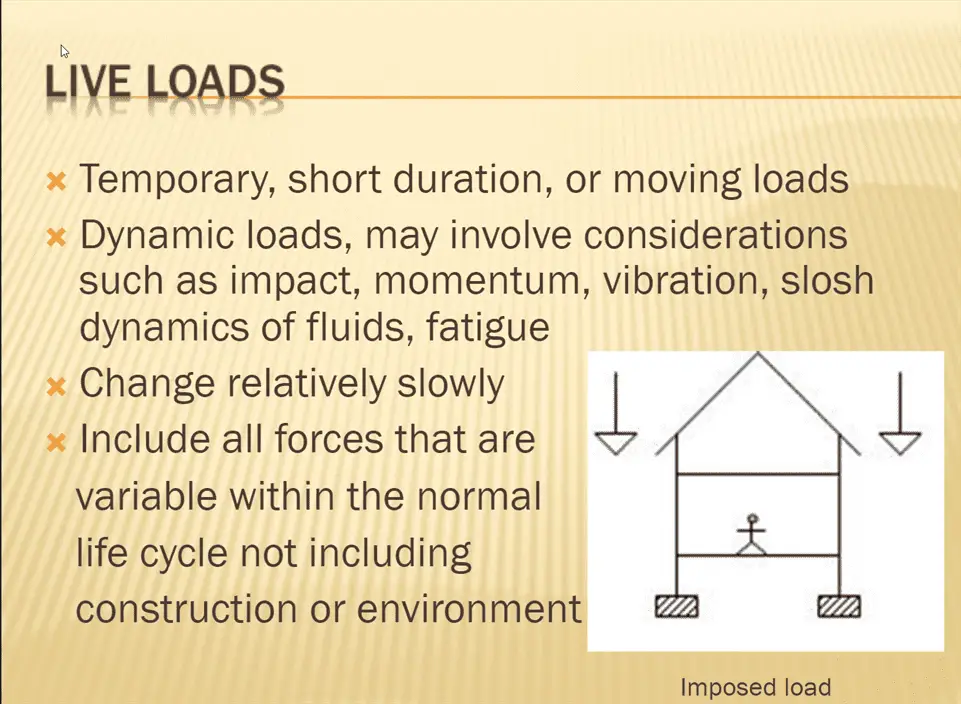
units of live load
The type of load being taken into consideration, and the standard or measuring method being used in the project, determine the units of live load. Typical live load units include:
| “pounds per square foot” (psf) (US) | load on floors, roofs |
Kilopascals (kPa) | load on structures |
| Newtons per square metre (N/m2). | load on beams, girders, and other linear elements. |
| “pounds per linear foot” (plf) | load on beams, girders, and other linear elements. |
| Kilograms per square meter (kg/m2) | floors, roofs, and decks |
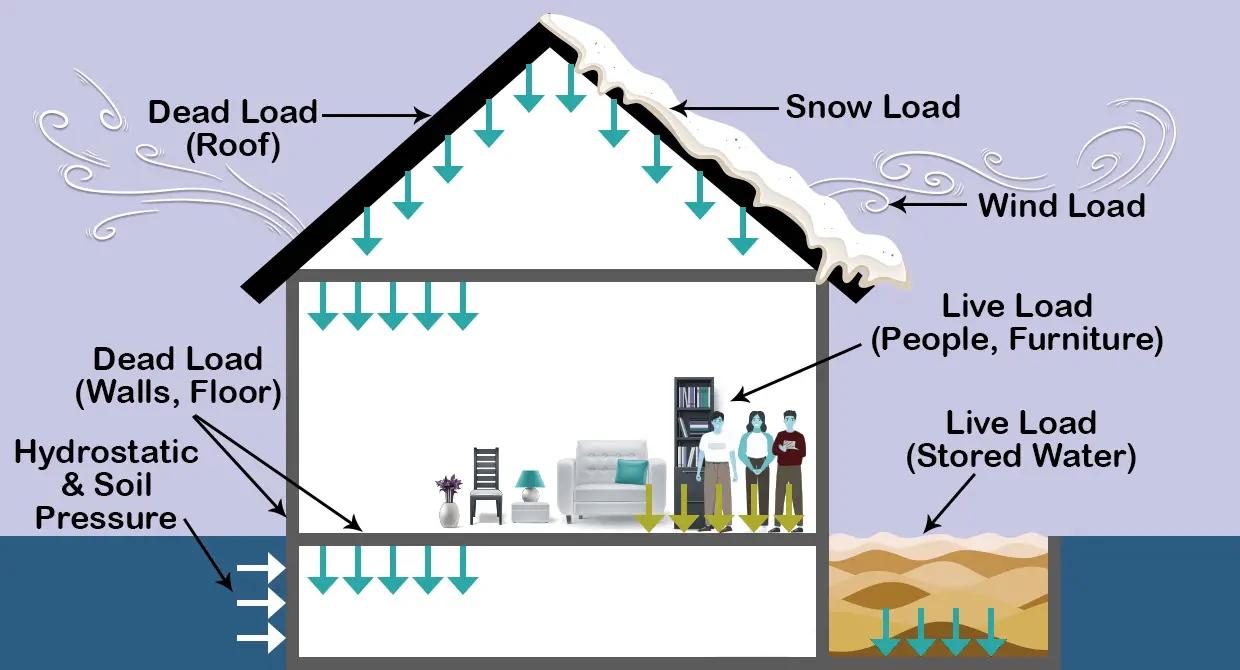
Live Loads in Trucking
The trucking industry relies heavily on properly accounting for live loads. Trucks routinely operate at maximum legal highway weight limits, producing high live loads on roads and bridges.
Some key live load considerations for trucks include:
- Axle Weights: Concentrated loads from truck axles are a critical bridge loading. Axle configuration determines load distribution.
- Gross Weight: Total truck weight must comply with legal limits. Extra heavy haul permits are required for overweight loads.
- Cargo Loads: Truck payloads produce high live loads. Cargo weight distribution affects axle weights.
- Dynamic Loads: Road roughness causes impact loading requiring increased strength. Slow travel speeds help reduce dynamics.
- Fatigue: Fluctuating axle loads from truck traffic can control bridge fatigue life.
- Posting: Over-stressed bridges may require lowering posted weight limits to reduce live loading.
- Permit Routing: Heavily loaded trucks may need permits and defined routes to avoid bridges with insufficient capacity.
Carefully accounting for these truck live loads is crucial for maintaining the integrity and service life of our roadway infrastructure.
Types of Live Loads according to Code
As per IS code 872(part2) -1987 live loads are of various types acting on the buildings. They include –
Imposed floor loads
The external load imposed on the structure irrespective of its self weight or dead load is called an imposed or superimposed load. This refers to the weight of people, equipment, furniture, and other movable items that are placed on a floor. The minimum imposed floor load in India is 2.5 kN/sq.m.
Live loads on roofs
Any load imposed on the roof of a structure like moving people, equipment etc . The minimum live load on roofs in India is 0.75 kN/sq.m.
Staircase loads
This refers to the weight of people who may use a staircase at any given time. The minimum staircase load in India is 2 kN/m^2.
Balcony loads
This includes the weight of people, furniture, plants and other items that may be present on a balcony. The minimum balcony load in India is 2 kN/m^2.
Lift loads
Lift adds additional load to the structure, which is considered as live load. It may also include the weight of the persons or equipment inside it. The minimum lift load in India is 2.5 kN.
The above mentioned values are only the minimum standards and may vary depending upon design requirements of the building.
Designers should always consider all potential live loads when designing a building to ensure that it is safe and can withstand the loads it will be subjected to throughout its lifespan.
Examples of live load in Detail
Live loads are nothing but moving superimposed loads on a structure. We can find a lot of examples in our daily lives. Here are some examples of live loads:
- People: The weight of people depends on the occupancy density and can range from 1.5 kN/m2 for a lightly loaded space to 7.5 kN/m2 for a heavily loaded space.
- Furniture: The weight of furniture like table desk etc ,depends on the type and density of furniture and can range from 1.0 kN/m2 for lightly furnished spaces to 5.0 kN/m2 for heavily furnished spaces.
- Equipment: The weight of equipment, such as machinery, computers, and appliances, is also a live load. It depends on the type and size of equipment and can range from 1.0 kN/m2 for lightly equipped spaces to 5.0 kN/m2 for heavily equipped spaces.
- Vehicles: The weight of vehicles, such as cars, trucks, and buses, is a live load for bridges, parking garages, and other structures that support vehicular traffic. The weight of vehicles depends on the size and type of vehicle and can range from 20 kN for a small car to 120 kN for a large truck.
- storage:The weight of stored goods and materials, such as in a warehouse or a storage facility, is a live load. The weight of stored goods depends on the type and density of goods and can range from 1.5 kN/m2 for lightly loaded storage spaces to 7.5 kN/m2 for heavily loaded storage spaces.

Dead loads VS Live loads
| sno | Dead load | Live loads |
| 1. | Static load | Imposed loads |
| 2. | Permanent load | Temporary, do not change with time. |
| 3. | Not movable | Static but movable |
| 4. | Constant loading | varying |
| 5. | KN | KN/m2, |
| 6. | Ex: Fixed members, equipment etc | Ex: people, furniture, equipment etc |
This live load vs dead load comparison article gives an in-depth review of both the loads.
Conclusion
In summary, live loads are highly variable forces imposed on structures that require specialized engineering analysis. Properly accounting for live loads in terms of strength, serviceability, uncertainty, dynamics, and fatigue is crucial for the safe design of buildings, bridges, and other structural systems. Understanding the types, magnitudes, distribution, and critical impacts of live loads is fundamental engineering knowledge for both analysis and design.
Frequently Asked Questions (FAQ)
What are live loads in logistics?
It is the type of transportation or shipment of the cargo in which the truck driver has to wait till the container is loaded or unloaded. This is opposite to the drop and hook process.
What is a live load board?
Live load board is an online platform that connects the shippers and carriers. It helps to find the availability of the loads and trucks in various locations. It gives the most accurate updates in finding best rates,routes and availability.
What are the live loads that vary with time?
They include the vehicle traffic on the bridges or roads , snow loads that occur seasonally, all maintenance works on the roof or floors of buildings. All these are not constant either they increase or may decrease with the time.
What are the live loads for school buildings?
In a school building all temporary and movable fixtures such as tables, chairs, benches, blackboards etc. accommodated in the building are referred to as live loads. They are usually specified by codes or standards based on the type and function of each room or area .According to IS 875 (Part-2)-1987, the minimum live load for a classroom is 3 kN/m2, while for a corridor it is 4 kN/m2
Live load calculation as per IS CODES
We use IS 875 (Part 2): “Dead loads, live loads, and wind loads for buildings and structures” for calculation of live loads.
Here are the general steps involved in live load calculation:
Determine the occupancy type
IS 875 provides guidelines for different occupancy types, such as residential buildings, office buildings, assembly buildings, and industrial buildings.
Calculate the live load
For calculating the live load, we need to multiply the applicable live load requirements by the floor area of the building. For example, if the live load requirement for an office building is 3.0 kN/m2, and the floor area of the building is 1000 square meters, the total live load will be 3.0 x 1000 = 3000 kN.
Account for load distribution
Live loads may vary from one floor to another. For example, the live load on the upper floors of a multi-story building may be lower than that on the ground floor. In such cases, engineers use load distribution factors from the code to determine the maximum expected weight on different areas of the building(.table 1 IS 875 PART2)
Consider dynamic loads
In some cases, the live load on a structure may be dynamic in nature. For example, a bridge may experience higher live loads when heavy vehicles pass over it. Engineers use dynamic load factors to account for such variations in live load.
Overall, live load calculation as per IS codes is an important aspect of building design in India and ensures that structures can support the weight of the occupants and the objects they bring in, without collapsing or failing under stress.
Key Takeaways:
- Live loads are variable forces applied to structures that can change over time, unlike permanent dead loads.
- Common examples are people, furniture, vehicles, wind, snow, fluids, and construction activities.
- Live loads types include concentrated, distributed, impact, moving, environmental, and construction.
- Live loads differ from dead loads in permanence, sources, magnitude, uncertainty, and how they are analyzed and factored.
- Calculating live loads involves identifying types, estimating magnitudes, determining tributary areas and distribution, applying load factors, and checking critical cases.
- Properly accounting for live loads is crucial for strength, serviceability, fatigue resistance, dynamics, uncertainty, and constructability.
- Trucking live loads like axle weights and dynamic impact are critical for maintaining roadways and bridges.




